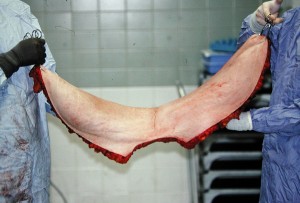The abdominal pannus is a stomach deformity where any amount of tissue hangs over the waistline. The term, pannus, is derived from a latin word for apron so it is fitting that any overhang is referred to as such. In days before bariatric surgery, abdominal panniculectomy surgery was very common and it was almost always associated with morbid obesity. Because of bariatric surgery, the most common abdominal panniculectomy today is much smaller and is done after large amounts of weight loss. These pannuses are largely skin and the overall health of the patient is generally good since they are more weight appropriate for their height.

In the October 2014 issue of the Annals of Plastic Surgery, an article was published entitled “Supersize” Abdominal Panniculectomy: Indications, Technique, and Results’. In this paper, the authors reviewed a series of 26 patients over a six year period that had abdominal panniculectomies performed that weighed over 10 kgs. (22 lbs), hence the term supersized pannus. The indications for surgery were typical including a large amount of overhanging abdominal skin and fat (hangs down to mid-thigh level) that was associated with underlying chronic skin infections, history of panniculitis, and the presence of a hernia. Of the 26 patients, the mean pannus weight removed was over 15 kgs with a followup period of over a year. The overall wound complication rate for the “supersize” panniculectomy over 40%. (11/26 patients). The rate of major complications, defined as those complications requiring a return to the operating room, was just over 10%. (3/26 patients).

This paper of larger abdominal panniculectomies supports what I tell my patients…the operation will be highly successful and can be life-changing but there is a very high incidence of wound complications and the need for further surgery/hospitalization is not rare. In the long run it will be very much worth it but expect a healing period of two to three months for a full recovery.
Dr. Barry Eppley
Indianapolis, Indiana


